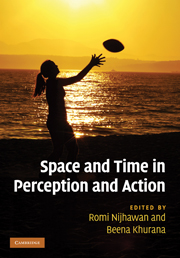Book contents
- Frontmatter
- Contents
- List of contributors
- Acknowledgments
- 1 Space and time: the fabric of thought and reality
- Part I Time–space during action: perisaccadic mislocalization and reaching
- Part II Temporal phenomena: perception
- Part III Temporal phenomena: binding and asynchrony
- Part IV Spatial phenomena: forward shift effects
- 19 The Fröhlich effect: past and present
- 20 Approaches to representational momentum: theories and models
- 21 Conceptual influence on the flash-lag effect and representational momentum
- 22 Perceptual asynchronies and the dual-channel differential latency hypothesis
- 23 Paying attention to the flash-lag effect
- 24 Illusions of time, space, and motion: flash-lag meets chopsticks and reversed phi
- 25 Bridging the gap: a model of common neural mechanisms underlying the Fröhlich effect, the flash-lag effect, and the representational momentum effect
- 26 Perceiving-the-present and a unifying theory of illusions
- 27 History and theory of flash-lag: past, present, and future
- Part V Space–time and awareness
- Index
- References
26 - Perceiving-the-present and a unifying theory of illusions
from Part IV - Spatial phenomena: forward shift effects
Published online by Cambridge University Press: 05 October 2010
- Frontmatter
- Contents
- List of contributors
- Acknowledgments
- 1 Space and time: the fabric of thought and reality
- Part I Time–space during action: perisaccadic mislocalization and reaching
- Part II Temporal phenomena: perception
- Part III Temporal phenomena: binding and asynchrony
- Part IV Spatial phenomena: forward shift effects
- 19 The Fröhlich effect: past and present
- 20 Approaches to representational momentum: theories and models
- 21 Conceptual influence on the flash-lag effect and representational momentum
- 22 Perceptual asynchronies and the dual-channel differential latency hypothesis
- 23 Paying attention to the flash-lag effect
- 24 Illusions of time, space, and motion: flash-lag meets chopsticks and reversed phi
- 25 Bridging the gap: a model of common neural mechanisms underlying the Fröhlich effect, the flash-lag effect, and the representational momentum effect
- 26 Perceiving-the-present and a unifying theory of illusions
- 27 History and theory of flash-lag: past, present, and future
- Part V Space–time and awareness
- Index
- References
Summary
Introduction
Accurately perceiving where objects are in one's visual field is important for making decisions and interacting with the environment, but the visual system must contend with a significant delay – on the order of 100 msec (Lennie 1981; Maunsell & Gibson 1992; Schmolesky et al. 1998) – between the time of retinal stimulation and the time of the elicited percept. To deal with this delay, it has been hypothesized that the visual system has been selected to attempt to generate a percept that compensates for it, so as to perceive the present (Ramachandran & Anstis 1990; De Valois and De Valois 1991; Nijhawan 1994, 1997, 2001, 2002; Berry et al. 1999; Schlag et al. 2000; Sheth et al. 2000; Khurana et al. 2000; Changizi 2001, 2003, 2009; Changizi & Widders 2002). One circumstance where perceiving the present is crucial is when an observer is moving forward and approaching objects. It has been proposed that the classical geometrical illusion stimuli are due to fixations during forward motion and that the illusions are an expected consequence of perceiving the present mechanisms; that is, the classical geometrical stimuli are perceived not as they actually project but as they would project in the next moment if the observer were moving forward (Changizi 2001, 2003; Changizi & Widders 2002). This theory has been used to explain geometrical illusions such as the Hering, Orbison (Ehrenstein), Ponzo, Muller-Lyer, and Poggendorf.
- Type
- Chapter
- Information
- Space and Time in Perception and Action , pp. 441 - 476Publisher: Cambridge University PressPrint publication year: 2010



